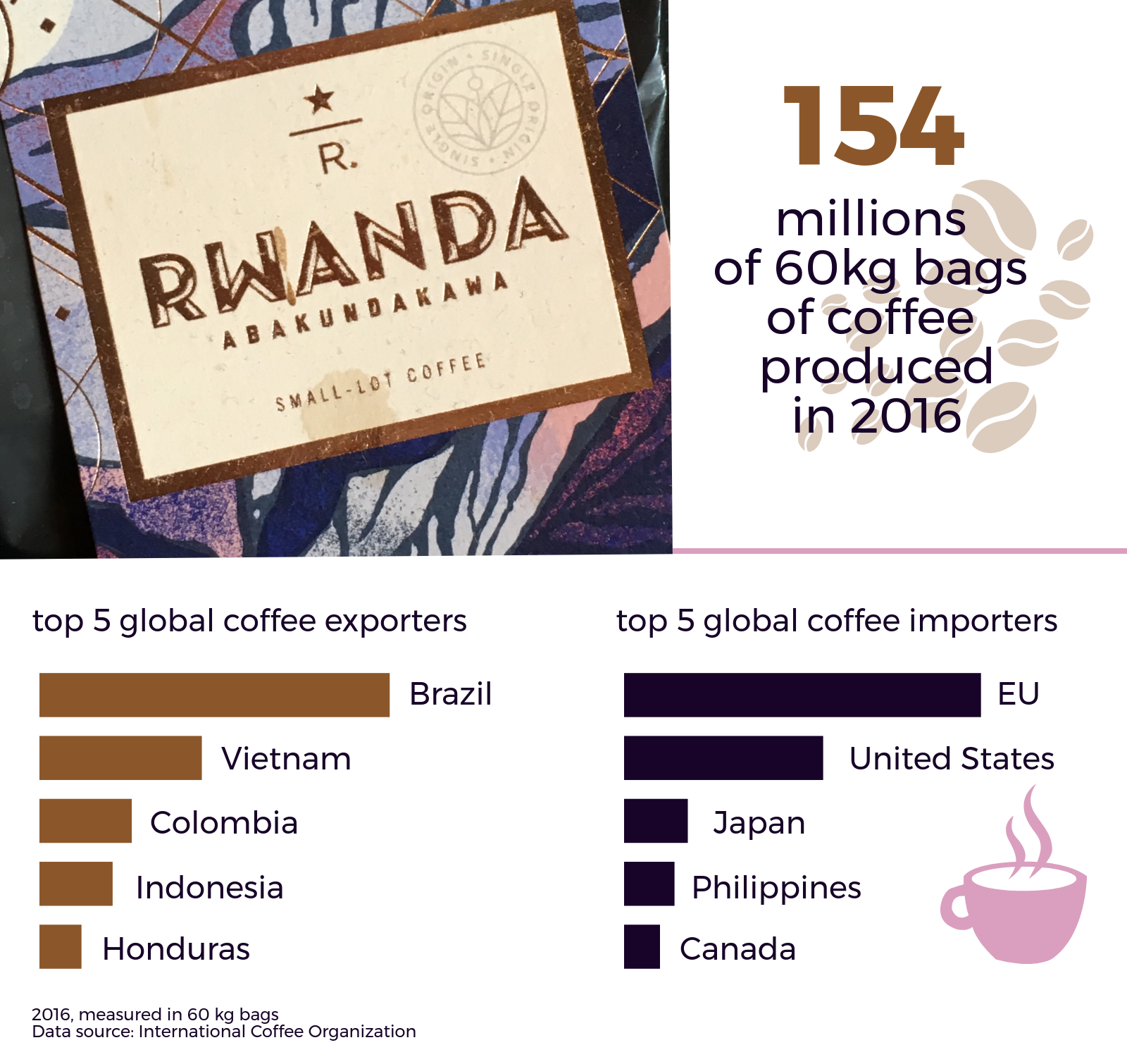Published 26 October 2017
If you're one of the millions of Americans headed to Starbucks for a seasonal pumpkin spice latte, the benefits of trade are right in your hand. Whether it's Starbucks or a boutique coffee shop, the coffee we drink is imported. Because while the United States excels at growing many crops, coffee beans aren't one of them.
Your Cup of Joe is Thanks to Trade
When talking to friends and family about international trade, their first reaction is often blank stares and then the inevitable declaration that “trade is way over my head”. In reality, it’s right in your hand if you’re one of the millions of Americans headed to the corner Starbucks for an iconic Pumpkin Spice Latte this autumn.
Starbucks released the iconic Pumpkin Spice Latte (“PSL” to those in the know) in 2003 and has since sold 350 million of this delightful autumn concoction of espresso, steamed milk, cinnamon, nutmeg, clove and pumpkin pie spices. The drink even has its own Twitter account, which alerts over 115,000 dedicated fans as to when it will appear in stores.
Whether you’re part of the annual PSL frenzy or just appreciate your regular cup of Joe, it’s all thanks to trade. Large coffee chains and local coffee shops alike depend on global supply chains to bring us a wide variety of ways to get our coffee fix.
Three Times the Caffeine Thanks to Millennials
Last year, 62 percent of Americans drank coffee every day, according to the National Coffee Association USA (NCA). Standing in line at Starbucks, it becomes clear who’s fueling the budget-busting latte habit. Since 2008, daily consumption of espresso-based coffee drinks has nearly tripled owing to a large increase from millennial consumers like myself.
The NCA says this is part of a larger trend. Daily coffee consumption by 18 to 24-year-olds nearly doubled from 25 percent to 48 percent between 2000 and 2016. Even America’s teens as young as thirteen are jumping on the coffee bandwagon. This year, the NCA saw daily consumption by coffee’s youngest drinkers increase from 31 to 37 percent.
Coffee Beans Thanks to Imports from “the Bean Belt”
The United States excels at growing a lot of crops, but with the exception of a handful of Hawaiian brands, we can’t grow coffee. Coffee plants thrive in “The Bean Belt,” an Equatorial zone roughly between the Tropics of Cancer and Capricorn. This stretch is home to the world’s top coffee exporters – Brazil, Indonesia, and Ethiopia to name a few. These subtropical countries have the right temperatures, soil, and elevation to grow coffee beans. The United States imported approximately 3.8 billion pounds of coffee last year alone, according to the International Coffee Organization (ICO).
International traders have been leveraging the climatic differences between regions for centuries. Starbucks’ colorful shelves demonstrate the diversity of coffee sources that include Peru, Ethiopia, Vietnam, Malawi, and Nicaragua. Trade agreements remove barriers and lower the cost of importing beans so coffee drinkers can experience varieties from most anywhere coffee is grown. Take the example of the U.S.-Colombia Trade Promotion Agreement. In the first three years after the agreement entered into force in 2012, U.S. coffee imports from Colombia increased by 33 percent. (U.S. exporters also grew their sales to Colombia, but in things we excel at producing such as chemicals, computer and electronic products, and transportation equipment.)

Variety and Livelihoods Thanks to Global Supply Chains
Starbucks purchases burlap bags filled with green coffee beans from regions in “the Bean Belt” and custom roasts them at one of five roasting locations— four in the U.S. and one in Amsterdam— to make their signature blends and single-origin coffees. Some of the single-origin coffees found on Starbucks’ shelves even come from war-torn areas such as Rwanda, East Timor, and the Congo.
Starbucks and other companies such as Nestle have partnered with international non-profit organizations to help local farmers reestablish their livelihoods growing coffee beans in areas shattered by decades of turmoil. It’s not charity. It’s economic development through business. The beans are high quality and considered rare or “artisanal” so they command anywhere from seven to eight times the average price of regular coffee beans.
Starbucks says 99 percent of its coffee is “ethically sourced” through the company’s Coffee and Farmer Equity (C.A.F.E.) Practices program. Although there is an ongoing debate about how to measure the impact these types of certification programs— including “Fairtrade” labeled coffee— have on local coffee farmers, Starbucks says it is committed to the success of its farmers and improving the lives of the one million people found in coffee growing communities around the world. Its main competitors such as Nestle also have programs focused on coffee growers in their supply chains.
Don’t take your PSL for granted
Thanks to trade, we enjoy a wide variety of products that we would otherwise not be able to grow or access — including our morning cup of coffee. But just because we’ve become accustomed to exotic beans, we shouldn’t take them for granted. Global supply chains can be vulnerable to a variety of risks. Coffee bean production is subject to variability in climate, coffee rust disease, fluctuations in commodity pricing, and more. And global supply chain disruption could ultimately mean no coffee on the shelves, no baristas, and no Starbucks hangouts.
Walking home with a PSL in hand, I don’t know if it was the autumn breeze or the idea of an America without coffee that made me shudder. Perhaps it’s a reminder for us all to take a moment to appreciate how trade impacts our daily routines. And — to think how different our lives might be if our coffee cups were empty.
© The Hinrich Foundation. See our website Terms and Conditions for our copyright and reprint policy. All statements of fact and the views, conclusions and recommendations expressed in this publication are the sole responsibility of the author(s).





